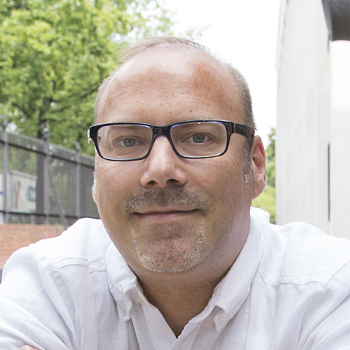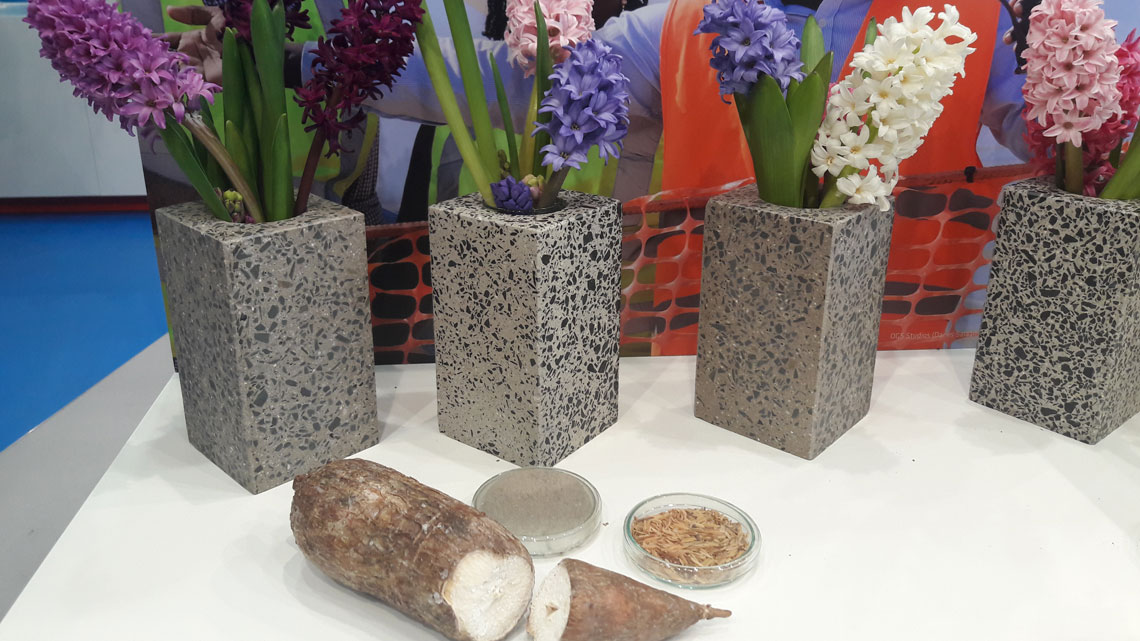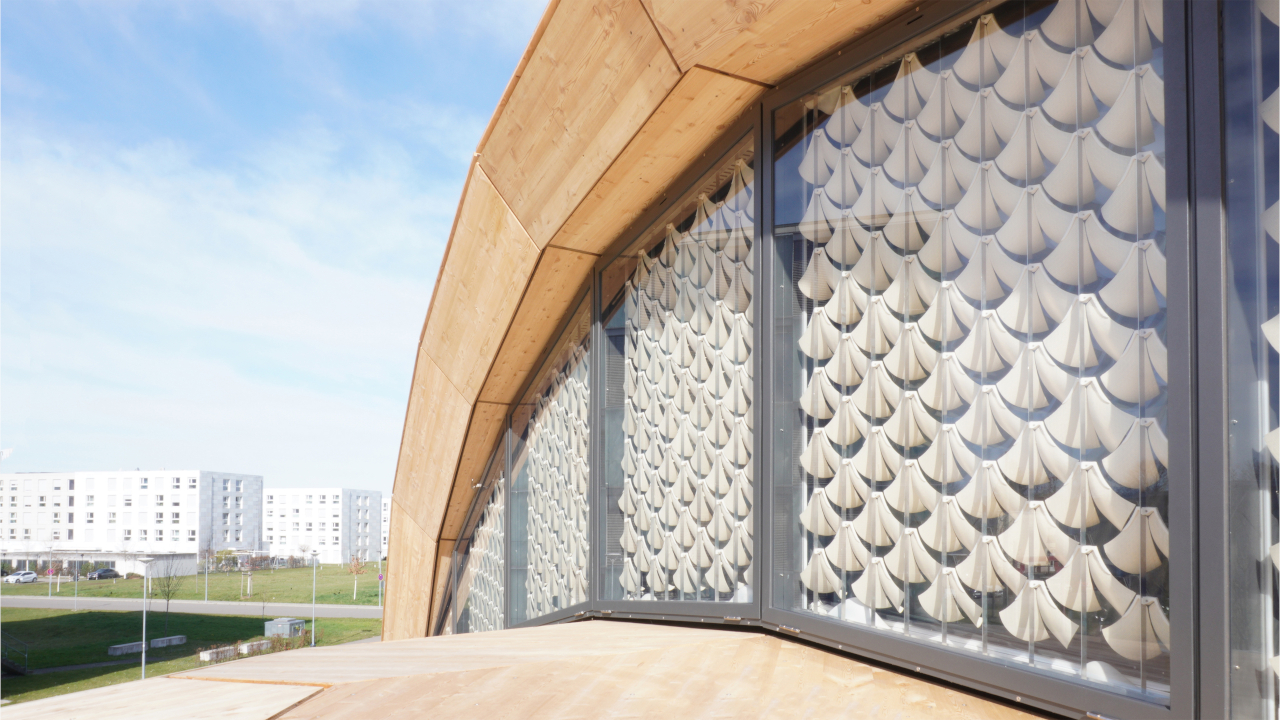The concrete mixer
Wolfram SchmidtProfession
Civil engineer
Position
Construction material and rheology expert at the Federal Institute for Materials Research and Testing (BAM)

Profession
Civil engineer
Position
Construction material and rheology expert at the Federal Institute for Materials Research and Testing (BAM)

Civil engineer Wolfram Schmidt aims to make concrete a more sustainable building material. Together with African partners, he has developed a bio-concrete based on manioc shells and other agricultural residues. For this achievement, the Federal Ministry of Education and Research has awarded him an innovation prize.
"Regarding technology, Europe will have to learn from Africa.” For many Europeans, this will sound strange, but it is Wolfram Schmidt's firm conviction - at least when it comes to the production of concrete. After all, the Earth's most important building material could be much more sustainable - without any loss in quality. In Africa, people are beginning to understand this for pragmatic reasons. In Europe, regulations and rigid views prevent the industry from massively improving its climate balance.
Schmidt is a materials researcher at the Federal Institute for Materials Research and Testing (Bundesanstalt für Materialforschung und -prüfung, short BAM). It is not ideology that drives the 43-year-old to promote more sustainable concrete, it is the findings of years of research. Schmidt initially wanted to work with concrete in a completely different way than he does today. "From the tenth grade on, it was clear to me that I wanted to become a civil engineer. The profile of the construction manager immediately appealed to me," he recalls. As a native of Cologne, the logical path led him to RWTH Aachen University after finishing school.
The appeal of practical research
"I was fascinated by the people who coordinate everything on the construction site. But the university also opened my eyes to completely different paths," says Schmidt, describing how his career aspirations were slowly changing. He briefly toyed with the idea of becoming a structural engineer. "But then, in the end, you only apply the laws of nature, with little opportunity to bring about active change.”
The deciding factor for his final decision was probably the parallel job with a company that focused intensively on materials and worked at the interface to the serial production of ceramic products. "There, I discovered my love for developing scientific facts and their further development into practical products," says the scientist. After his diploma thesis on the optimization of concrete formulations, it was clear to him: "I will remain in materials research.”
"The temperature and the mixture alone can change so much about the product," enthuses Schmidt. "It's like at home in the kitchen.” In fact, he is also the one at home who usually cooks for his wife and two children on weekends - "because it's fun!”
Passion for international projects
A fitting job advertisement led Schmidt to the BAM immediately after completing his studies. "At that time, I thought: Two years, then I'll look for a research-related job in the industry," he remembers. From the very start, Schmidt drove international projects forward at the institution, which at the time was still rather nationally oriented. "I really enjoyed it" - so much so that he did his doctorate at the TU Eindhoven at the same time in order to continue his research at BAM, where he still is today.
He had come into contact with an increasing number of research questions. Africa and renewable resources - a topic that has stayed with him to this day - was just one of many topics. "Technically, I am responsible for everything to do with rheology, therefore I try to find relevant interfaces between the topics," he smiles. This leaves little time for leisure; the researcher spends several months a year abroad.
But is there really still so much that can be researched and improved in concrete? "Concrete is a hell of a complex system with particles ranging from nanometers to centimeters, and we pour cubic meters from it," Schmidt explains. In order to really understand this material, as a civil engineer he first had to learn organic and inorganic chemistry down to the nano level. "But the deeper you immerse yourself in specialist knowledge, the more intensively and regularly you ask yourself the question of what other benefits you will generate for society," says the man who wants to move things forward.
Africa is different
"In Africa, I have seen that the world is completely different." In terms of purchasing power, cement is between 10 and 1000 percent more expensive there than in Europe. Good practice rules often cannot be adequately applied due to technical shortcomings. "In Germany you can order concrete, and two hours later it is there in the requested consistency. In Africa, there is no infrastructure for this," reports Schmidt. Because the material is extremely expensive, but labour costs little, other ways of producing concrete are in demand than in Europe, where the situation is exactly the opposite.
"The basics of chemistry and physics are the same everywhere, but you have to adapt concrete production to local conditions," the materials researcher describes his goals. It is crucial for Africa that, due to the poor infrastructure, only local production can be economically viable. Short transport distances benefit the climate - and this would also be true outside of Africa. To this end, Schmidt relies on bio-based raw materials. In Africa, he and his colleagues from Nigeria found the shell of the manioc root to be the ideal concrete ingredient. Due to its indigestibility, this unused waste material is unsuitable as animal feed, but is produced in rough quantities, because manioc is the world's most important source of starch after corn and rice. "In Europe, building materials are regulated in such a way that concrete can only be optimized in small steps. Leap innovations are still possible in Africa," says Schmidt. This is why he is convinced that Europe will learn from Africa in a few years' time.
Awarded with innovation prize
In Africa, he was consistently supported by Professor Herbert Uzoegbo of the University of the Witwatersrand in Johannesburg, even though Uzoegbo could no longer be active in research for health reasons. "The regulations and administrative conditions in Europe and Africa don't mesh so well", jokes Schmidt, Uzoegbo has always "built bridges across the continents" in this regard. "And I learned from him that in Africa you can't afford the luxury of being a specialist, but that you have to be an all-rounder." Together with Kolawole Olonade from the University of Lagos, Schmidt was recently awarded the German-African Innovation Prize by Federal Research Minister Anja Karliczek for his work.
The rough shells of the manioc tuber provide an ash that is highly suitable for concrete production. Vases 1 and 3 are made of the bio-based concrete.

"The basics of chemistry and physics are the same everywhere, but you have to adapt concrete production to local conditions," the materials researcher describes his goals. It is crucial for Africa that, due to the poor infrastructure, only local production can be economically viable. Short transport distances benefit the climate - and this would also be true outside of Africa. To this end, Schmidt relies on bio-based raw materials. In Africa, he and his colleagues from Nigeria found the shell of the manioc root to be the ideal concrete ingredient. Due to its indigestibility, this unused waste material is unsuitable as animal feed, but is produced in rough quantities, because manioc is the world's most important source of starch after corn and rice. "In Europe, building materials are regulated in such a way that concrete can only be optimized in small steps. Leap innovations are still possible in Africa," says Schmidt. This is why he is convinced that Europe will learn from Africa in a few years' time.
Awarded with innovation prize
In Africa, he was consistently supported by Prof. Herbert Uzoegbo of the University of the Witwatersrand in Johannesburg, even though Uzoegbo could no longer be active in research for health reasons. "The regulations and administrative conditions in Europe and Africa don't mesh so well", jokes Schmidt, Uzoegbo has always "built bridges across the continents" in this regard. "And I learned from him that in Africa you can't afford the luxury of being a specialist, but that you have to be an all-rounder." Together with Kolawole Olonade from the University of Lagos, Schmidt was recently awarded the German-African Innovation Prize by Federal Research Minister Anja Karliczek for his work.
Manioc shells for concrete production
Manioc shells, as waste from agricultural production, provide several raw materials for concrete production at once. Residues of starch on the shell also have liquefying properties, but increase the viscosity - a desired but inherently contradictory combination. The energy released during the incineration of the shells can be used for brick production. And the remaining ash, with its cement-like properties, replaces the fly ashes commonly used in Europe.
Schmidt now wants to carry the findings from Africa into the world. "Half of what humanity produces is concrete, which is responsible for five to ten percent of global CO2 emissions," the researcher warns. Cement consumption in the emerging markets is only just starting. So it is not idealism that drives him, but the bare figures. "If we only cut cement consumption by a few percent, that would be a huge lever due to the volume." The new findings from research must therefore now be put into the heads of the students, "because only the next generation of decision-makers can bring about real change".
Author: Björn Lohmann


